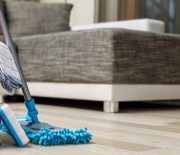Last update: 1 year ago

The couch – a place where Netflix marathons take place, 3-hour unscheduled naps happen, and where your casual work-from-home station is. It’s only a matter of time before the daily use starts to show.
No matter how careful we are, the crevices are a magnet for crumbs, dust, and hair; while the cushions magically trap coffee spills, water stains, and what have you. Especially those poor natural fibre sofas that absorb the stains as it’s their business. Fabric couches can be a beautiful addition to any home, but let’s be real – they’re quite tricky to clean.
Fret not! Simply follow our step-by-step process of cleaning fabric furniture. We’ll guide you through the process – from deodorising your couch to spot-cleaning stains. Let’s go!
Prepare your fabric sofa for cleaning
To prepare your couch for cleaning start by vacuuming the whole surface, the crevices and under the cushions. Loosen up old stains or dirt by using a stiff brush with natural bristles. Then vacuum that part again.
Some fabric furniture has removable covers that you can put in the washing machine. If that’s your case, you can skip directly to the spot-cleaning section after washing. See you there.
P.S. Should we even mention reading the label before doing anything to your couch?
The fabrics can vary from natural to artificial and various blends between both.
Natural Fibers
Usually, a couch isn’t made entirely of natural fibres – they’re mostly blends. They’re also often a bit more pricey, and they require a bit of special attention (what doesn’t really?). Some popular natural textiles include:
- Linen
- Cotton
- Wool
Synthetics
Before proceeding with the cleaning, it’s essential to know what textile you’re dealing with as some synthetic materials have very specific instructions for cleaning. Types of synthetic textiles your furniture can be made out of:
- Polyester
- Velvet
- Microfiber
- Rayon
- Sunbrella
Follow the manufacturer’s instructions
Something that we can skip saying, but we won’t, is that you should read the manufacturer’s label.
And if you thought cleaning natural textiles is tricky, wait until you hear about microfibre. It’s usually the one with the most specific instructions, as it can be easily damaged if you use the wrong detergent. But no matter what kind of textile the upholstered furniture has, the manufacturers put in letter coding to help you out. Here’s what you can find on the care label and what it means:
- W – It means it’s safe to use water and water-based solutions while cleaning.
- S – Only use solvents to clean the upholstery (dry clean).
- S/W – You can use solvents or water-based cleaners. In this case, both dry cleaning using a mild solution and steam cleaning are good options.
- X – Vacuum only, don’t use water.
Deodorize and clean your upholstery with baking soda
It wouldn’t be a cleaning tutorial if we didn’t mention baking soda. As many of you already know, baking soda is a key ingredient in all kinds of DIY cleaners. It’s easily accessible and generally safe to use on various surfaces, and that includes your upholstery. Needless to say, always test on an unnoticeable area first.
How to clean upholstery with baking soda
Coat the surface of the couch with a little bit of baking soda and let it sit for about half an hour. Don’t overdo it with the amount of baking soda. You only need light coverage. After that, use the brush attachment to vacuum it away. Voila! What you’re left with is a deodorised and gently cleaned couch. Repeat whenever you feel the need to freshen up your upholstered furniture. And if you’d like to do a deep clean, just mix the baking soda with dry upholstery/carpet cleaner and repeat the same process. You’re welcome.
Remove stubborn stains and deep clean your fabric sofa
Even after all the work you just did, you might be left with a couple of persistent stains and ambiguous-looking spots.
Fabrics, especially natural ones, are prone to stain easily, so working fast is key. The more time has passed, the harder it is to get rid of them. And since all mishaps happen suddenly, you often need to DIY your cleaning products. And as always – spot-test on a hidden area first, please!
Deep cleaning your sofa on your own might seem like an impossible task. But since you’re here, we know you’re not a quitter, so here are a few methods to do that.
Another option is that you just call cleaners to professionally deep clean your upholstered furniture while you sit back and relax. This way you don’t have to do all the hard work and there is no chance of damaging your furniture. Hint: we can do this for you.
Cleaning with water, vinegar and dish soap – Spot-cleaning
Grab yourself a bowl, half-full of warm water and mix in 3 tbsp of white vinegar and 1 tbsp of mild dish soap (the amount can vary). Dab it with a clean cloth or a sponge and spot-treat stains one by one. Try not to soak the furniture. Work gently because you don’t want to rub the stain into the fabric. Wipe away with a clean cloth and inspect if the stain is gone. If not, repeat the process. Let it air-dry. No need to use blow-driers or heaters, as they can do more damage than good.
Cleaning with water, vinegar and dish soap – Large surfaces
To clean larger surfaces of upholstered furniture, you might need something else. In a completely clean spray bottle, mix together a cup of warm water, half a cup of white vinegar and 1 tbsp of dish soap. Close it and shake it well. Spray the surface of the couch from a 30 cm distance, then wipe away with a clean cloth to ensure there’s no excess residue from the solution on the furniture. Let it air-dry.
After it dries, the vinegar smell goes away, leaving behind just a clean, freshened-up couch. This method is more suitable for synthetic textiles except for suede and as we already mentioned – some types of microfibre. It’s also a great choice for cleaning synthetic carpeting.
Cleaning with baking soda paste
You thought we were done with the baking soda? No way! Mix baking powder and just enough water to make a paste and you have a two-ingredient homemade solution to remove stubborn and greasy stains. Put a little bit of it on the stain and with the tip of your finger or a clean cloth, gently rub it in with circular motions. No scrubbing, as it will push the dirt deeper into the textile, making it a bigger problem than it should be. Leave the paste on for about 15 minutes. Check if the soda has absorbed the grease and once it has, brush it off or vacuum it with the bristle brush attachment.
Clean with a cleaning product
If you happen to have at home an upholstery or a carpet cleaning product (that you actually bought from the store, shocker!), the first thing you need to check is if it’s a water-based cleaner or solvent and whether it’s suitable for your furniture piece. Remember the W, S, S/W, X code scheme we explained above? Spot-treat on an inconspicuous area and if there’s no discolouration or other problems, proceed with the cleaning by following the instructions on the label. After treating, you can soak up any residual moisture with a towel, then let the piece to air-dry.
How to keep your sofa clean
To keep your sofa clean all the time, incorporate regular vacuuming in your schedule and take care of food and drink spills immediately, so they don’t stain the fabric. You can try and keep your pets off the sofa or just give them a blanket so they have a special place next to you when you sit down. Another way to protect your upholstered furniture is to treat it with a fabric protection product (again, make sure it’s suitable for your piece).
When you clean light-coloured sofas, make sure you use white or at least light-coloured cloths too. This ensures no textile dyes will transfer from the cloth to the upholstery you’re cleaning.
If you want to take it to the next level, use distilled water when cleaning because tap water leaves residues behind and in some cases, it can actually look like a stain.
Takeaways
And a few tips that are not necessarily connected with cleaning but have to be mentioned:
- To preserve your sofa’s fresh and vibrant colours, choose a place for it out of the sun and away from any heat source. Sun and heat can not only discolour your furniture but also damage it beyond repair.
- If you wash the covers in the washing machine, don’t let them dry in the blazing sun.
- Revive your couch by deep cleaning it once or twice a year,
- Do that by yourself with some of the methods above or by calling in a professional cleaning company to do that for you.
Does deep cleaning your fabric upholstery sound like too much?
Let us do the dirty work!
And with that, we hope you found the tips and ideas useful. Tell us in the comments below if you tried any method and how it went for you.








